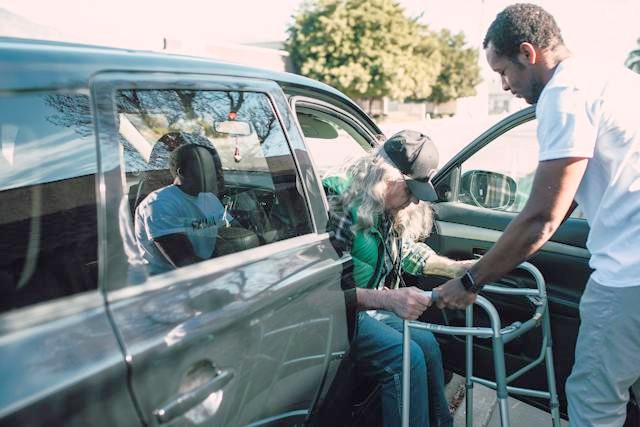According to a report by USAging, about 600,000 older adults stop driving every year. Health conditions may make driving difficult, and they must find other ways to get around. This makes it hard for them to go to doctor’s appointments, shopping, visit family, or attend social events. They become more isolated, which negatively affects their health and well-being.
Most older and disabled adults rely on their family, friends, and neighbors for rides. But these may not always be available. Affordable transportation can help you to stay connected to your family, friends, and community. Here are six local transportation options you can use to get around.
County Public Transportation Services for Seniors
Most U.S. counties offer low-cost or free transportation for seniors to medical appointments and other places. The services are designed for seniors who need door-to-door rides. To find out if the program is available in your county’s Area Agency on Aging. You’ll be connected with the available local programs.
You can also use the ElderCareLocator to learn about free or low-cost transportation options. The website will help you find local government transportation programs. To get started, enter your zip code in the search box on the home page.
Free Transit Program
Some cities in the U.S. have eliminated public transportation fares, making it completely free to encourage people to use public transit, reduce carbon emissions, and help low-income riders.
Kansas City, Missouri, was the first city to offer free public transportation, and residents now pay zero fares on the trams. Other cities that have followed suit include:
It should be noted that zero fares in the listed cities depend on the type of transport used and the routes.
- Ohio: Akron
- Maryland: Baltimore City
- Massachusetts: Boston
- Oregon: Corvallis
- New Jersey: Hoboken
- Washington: Island County,
- Montana: Missoula
- New Mexico: North Central New Mexico
- Washington: Olympia
- Virginia: Richmond
- Georgia: Savannah
- Arizona: Tucson
- South Carolina: Clemson,
- Utah: Cache Valley, Park City
- California: Commerce, Emeryville,
- North Carolina: Chapel Hill, Raleigh
- Virginia: Alexandria, Richmond
- Colorado: Avon, Breckenridge, Summit County, Vail
Recommended for: Seniors who don’t need assistance to get in and out of a car.
Volunteer Transportation Programs

These transportation programs provide free door-to-door transportation services to seniors and the disabled. Check with your local nonprofit to get a list of volunteers who drive seniors and the disabled door-to-door for errands and appointments.
It’s worth mentioning that the vehicles used by volunteer drivers can’t transport motorized wheelchairs because they are regular vehicles. To find out if there’s a Volunteer Driver Program in your state, visit this map.
Recommended for: Seniors who don’t need assistance to get in and out of a car.
Public Transit
Bus and rail services managed by federal, state, and local governments usually offer discounted fares for seniors and people with disabilities. Some provide vouchers to help travelers save some money.
Public transit systems usually have fixed routes and set schedules, and some provide free training to help you learn to travel safely. Most transport modes have accessibility features. But if you have a disability or have difficulty navigating stairs, this may not be the best option for you.
Recommended for: Seniors who don’t need assistance to get in and out of a car.
Non-Emergency Medical Transportation (NEMT)
This transportation service is designed for seniors and individuals who don’t have an emergency but need more assistance than a taxi service can provide. Each service provider is specially equipped to transport riders in stretchers, wheelchairs, or with other special needs.
Non-emergency medical appointments include dentist appointments, exercise programs, therapies, and other health-related appointments
NEMT serves Medicaid beneficiaries, and NEMT providers must not only provide transportation but also choose the best vehicle and cover all transportation-related expenses. This means you pay nothing (or next to nothing) for transport to and from medical appointments. But since provider networks vary, schedule a ride in advance.
Recommended for: Seniors who need assistance to get in and out of a car.

Para-Transit Services
All senior citizens are entitled to transportation services under the Americans with Disabilities Act (ADA). Para-transit services are provided alongside a city’s public transportation and are meant for people with disabilities. They are usually available near a bus route or rail station on the same days and times. But the fare is slightly higher than the regular fare.
Many paratransit vehicles are wheelchair and handicapped-accessible. The transport systems offer curb-to-curb service within their designated routes. But curbside service differs from door-to-door service. Drivers do not go into seniors’ homes to help them enter and exit the vehicles. Also, the vehicles are in high demand, so you must be patient and flexible when planning your outings.
Recommended for: Seniors who don’t need assistance to get in and out of a car.
Ride-Hailing Services
If you have a smartphone and don’t need assistance to get in and out of a car, you can use ride-sharing apps like Uber and Lyft. A loved one can also order a ride for you from their smartphone.
Ride-hailing companies have many accessible vehicles to cater to seniors and people with disabilities. You can request a car whenever you need, and the driver’s name and license plate number are provided.
Recommended for: Seniors who don’t need assistance to get in and out of a car.
Senior Community Transportation
Most senior living communities have a concierge program that provides transportation services. Handicap accessible may be available to help residents get to their medical appointments, go shopping, etc.
You won’t pay anything extra since transport services costs are included in the monthly fee. But most communities don’t offer one-on-one support. The driver may help residents get in and out of a doctor’s office or a store, but they won’t wait for you throughout. Be sure to know the transportation times, as they are usually scheduled in advance.
GoGoGrandparent
This concierge service makes on-demand transportation accessible and reliable so the elderly can thrive independently at home and in the community. It connects you with on-demand ride services like Uber and Lyft. You can get a car at your location in minutes.
It’s worth mentioning that you’ll pay for the on-demand ride as well as the concierge service, but it’s generally more affordable than getting a taxi.
GoGoGrandparent monitors rides and screens drivers, and notifications about the ride are sent to family members.
Recommended for: Seniors who don’t need assistance to get in and out of a car.
Veyo
Veyo partners with health facilities and insurance companies to offer non-emergency medical transportation. Transportation is provided as an insurance benefit, so find out from your insurance company if Veyo is available on your plan. If it is, request them to schedule rides. You can’t sign up for the service, only a Veyo partner can
Recommended for: Seniors who need a special vehicle to accommodate a wheelchair or stretcher.

Alice is a writer and editor for Gainful Retirement. She is passionate about helping retirees live fulfilling lives without financial constraints. She puts a lot of time and effort conducting market research to identify common issues faced by retirees. Her passion is to help you enjoy retirement and solve the most pressing issues you face.
